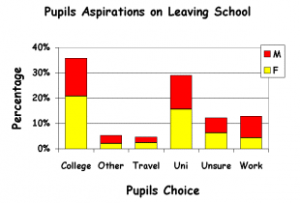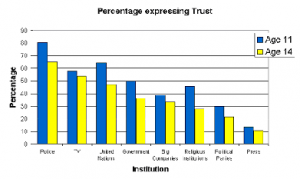BACK TO GET DATA
2003/2004
Latest
CensusAtSchool 4 Results
Children in the UK took part in the CensusAtSchool 4 survey during the academic year 2003/4. Over 17,000 pupils have so far taken part in CensusAtSchool 4, 52% were female and 48% were male. The majority of pupils completing the questionnaire were aged between 11-14 (Key Stage 3).
– Interesting findings from results:
- In CensusAtSchool 1 (2000-2001) we asked pupils how many of them owned a mobile phone. 40% of them said they did. Just four years later, in CensusAtSchool 4 we asked the same question again and found that this figure has increased to a staggering 89%. Likewise children having access to the Internet has increased from 60% to 82%.
- Reaction times also provided interesting data.
- 64% of the pupils thought they would continue with their education on leaving school with 29% stating a preference for going straight from school to University. Girls are more likely to aspire to further education than boys: who appear to have a greater yearn for the working life. Of the 17,000 pupils, 89 specifically said they wanted to become a ‘football player’, 4 said ‘get married’ and individual aspirations where to ‘work with dolphiins’, ‘rob a bank’ and ‘manage a pub’!

- R&B and Pop are the most popular types of music choice for pupils to listen to with Rock a close third. Classical music is the least popular. Children prefer reading Adventure and Horror stories to Factual books although Real Life stories are third most popular.Involving the children and asking their opinions generates interest. Their views and opinions can be quite different to the views of adults. Asking adults which of eight institutions children would say they trusted the most, ‘television’ was the answer every time. However the children say that it is the ‘police’ they trust the most with ‘television’ second. By far the least trusted are the ‘press’. Interestingly there are gender differences, with girls appearing to be more trusting than boys. More worryingly, it seems that there is a dramatic decrease in trust from 11 to 14 year olds, especially for the police and religious institutions.

- We are continually working on the data to provide useful information. Using real data allows pupils to appreciate the problems and want to know how to solve them. A few Phase 4 records could be considered ‘interesting’. Some pupils are 210cm tall with a foot size of 9cm? Others want to do ‘nothing’ when leaving school, play the bagpipes and have extremely slow reaction times! These lines of data seldom make it through to our final databases. However, dodgy data such as these are used for our curriculum resources in order to try and encourage children to spot errors in data. Since they collect their own information, they can deduce valid reasons for the dodgy data and decide how best to deal with them. This helps children understand how to deal with statistics thrown at them by the media and found in the workplace.Further graphs and chunks of data from Phase 4 are available throughout the site.Below are two fixed random samples of the data consisting of 100 records each.
Sample 1 (XLS)
Sample 2 (XLS)
